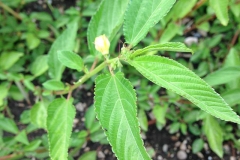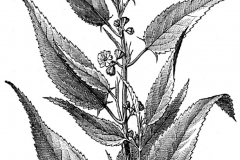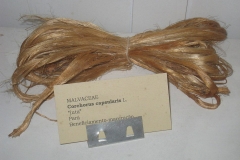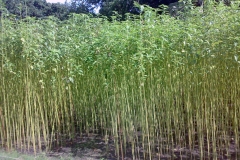Plant Description
White Jute is an erect, annual to perennial plant that grows about two or more meters in height, unbranched or with only a few side branches. The plant is found growing in low-lying watery places, among field hedges or along the border of cultivated fields, degraded forest areas and along sides of water courses. The stems are usually purplish. The leaves are ovate-lanceolate 5-12 cm long, pointed at the tip and rounded at the base, with tail-like projections on each side of the midrib, and toothed at the margins. The flowers are borne in small groups in the axils of the leaves, and are about 4 mm long. The sepals are often purplish and the petals are yellow. The many seeded globose to globose-obovoid capsules is about 1 centimeter in diameter, with longitudinal ridges. This species produces the greatest part of the jute of commerce, being about ten times as abundant as Corchorus olitorius. It is cultivated in India, and is also grown for its fiber in the Yangtze Valley of China.
It thrives almost anywhere, and can be grown year-round. Most genera are tropical, but the genus Tilia, commonly called linden, or lime tree, in Europe and Asia and basswood in North America, is found throughout the north temperate. Many species yield fiber, but the chief sources of commercial jute are two species; C. capsularis and C. olitorius, grown primarily in the Ganges and Brahmaputra valleys. Although jute adapts well to loamy soil in any hot and humid region, cultivation and harvesting require abundant cheap labor, and India remains the unrivaled world producer as well as the chief fiber processor. Kolkata (Calcutta) is the main center. Europe and the United States import large quantities of jute fiber and cloth.
- Leaves are appetizer, carminative, demulcent, laxative, stimulant and stomachic.
- An infusion is used in the treatment of dysentery, fevers, and dyspepsia and liver disorders.
- Decoction of the roots and unripe fruits is used in the treatment of dysentery.
- Leaves have been used to increase appetite, as an aid to digestion, as a laxative and as a stimulant.
- An infusion of the leaves has been used to reduce fever, and the roots and leaves have been used against dysentery.
Ayurvedic Health benefits of White Jute
- Dry Skin: Grind few leaves of White Jute to make out a paste. Apply a thin layer of this to your skin. Repeat this treatment daily to get the smooth and soft skin.
- Dandruff: Grind the fresh leaves of White Jute to make a paste. Apply this paste on your scalp. Allow it to dry for 1 hour. Wash off your scalp with water. Repeat this procedure for twice a week to get rid of Dandruff.
- Hair fall: Paste prepared from White Jute leaves induces the growth of hair. Apply this paste twice a week. This paste will make your hair strong.
Culinary uses
- Leaves can be consumed raw or cooked.
- Young leaves are added to salads whilst older leaves are cooked as a pot-herb.
- Tea is made from the dried leaves.
- Immature fruits are added to salads or used as a potherb.
- Leaves and shoots of this plant are widely eaten in salads when young and are used as a cooked leafy vegetable when older.
- Leaves are dried and powdered to use as a thickener in soups or as an herbal tea.
- Immature fruits are also eaten, raw or cooked.
- It makes an excellent spinach substitute in areas with hot summers.
Other facts
- Fiber is obtained from the stems; it is the main source of jute.
- Fiber is slightly coarse and is used mainly for sackcloth etc.
- Stems are harvested when the plant is in flower and are then retted (allowed to begin to rot) so that the fiber can be extracted.
- Growing the plants very close together will prevent some of the branching.
- If used in making paper, the fibers are cooked for 2 hours with lye and then ball milled for 4½ hours.
- The paper is grey/buff.
- The very light and soft wood is used in making sulphur matches.
- It is used for making sacks, bags, carpets, curtains, fabrics and paper.
References:
https://www.itis.gov/servlet/SingleRpt/SingleRpt?search_topic=TSN&search_value=506092#null
https://npgsweb.ars-grin.gov/gringlobal/taxonomydetail.aspx?id=11456
https://pfaf.org/user/Plant.aspx?LatinName=Corchorus+capsularis
https://plants.usda.gov/core/profile?symbol=COCA38
https://en.wikipedia.org/wiki/Corchorus_capsularis
http://www.theplantlist.org/tpl/record/kew-2736337
https://indiabiodiversity.org/species/show/229279
http://tropical.theferns.info/viewtropical.php?id=Corchorus+capsularis
https://gd.eppo.int/taxon/CRGCA
https://en.wikipedia.org/wiki/Corchorus_capsularis
https://www.cabi.org/isc/datasheet/16020
Comments
| White Jute Quick Facts | |
|---|---|
| Name: | White Jute |
| Scientific Name: | Corchorus capsularis |
| Origin | Originated in China but is now grown in Bangladesh and India, and found spread across much of tropical Africa |
| Shapes | Many seeded globose to globose-obovoid capsules, about 1 centimeter in diameter |
| Taste | Bitter |
| Health benefits | Beneficial for dysentery, fevers, dyspepsia liver disorders and helps to increase appetite. |
| Name | White Jute |
|---|---|
| Scientific Name | Corchorus capsularis |
| Native | Originated in China but is now grown in Bangladesh and India, and found spread across much of tropical Africa. It is also cultivated in the Amazon region of Brazil |
| Common Names | Bangla white jute, Jute, White jute, round-podded jute, jute plant, jute, Nalta jute |
| Name in Other Languages | Arabic: Jût (جوت ), خَيْش , aljuti (الجوتي), jawtiat kabsulia (جوتية كبسولية) Assamese: Chutia-pata, Nalita, Nali-sak, Mora-pat, Mora pat, mara shaak (মৰা শাক) Azerbaijani: Girdəmeyvə cut Basque: Jute Bengali: Jhuto, koshta (কোষ্টা) Catalan: Jute Chinese: Hunag ma (黄麻), Yuan guo huang ma (圆果黄 麻) Danish: Rundkapslet jute, Hvid jute Dutch: Blanke jute, Juteplant, Rondpeulige jute English: Bangla white jute (India), Jute, White jute, round-podded jute, jute plant, jute, Nalta jute Finnish: Juutti, Kuitujuutti French: Chanvre de Calcutta, Corète textile, Corète capsulaire, Corette, Gooni, Jute à fruit capsulaire, Jute à capsules globuleuses German: Indischer flacks, Jutepflanze, Rundkapseljute, Rundkapsel-Jute, Weiße Jute Greek: Lefki giuta (Λευκή γιούτα), Giuta me sfairika perikardia (Γιούτα με σφαιρικά περικάρπια), Giuta me sfairikus karpus (Γιούτα με σφαιρικούς καρπούς) Gujarati: Śaṇa (શણ) Hindi: Patsan (पटसन), Shuti paat, Tita paat, San (शन), Narincha, patta shaak (पट्ट शाक) Indonesian: Yute Italian: Corcoro, Iuta a frutto capsulare, Iuta bianca, Juta Bianca, juta Japanese: Ichibi Kouma (コウマ), tsunaso (ツナソ) Javanese: Yute Kannada: Senabu (ಸೆಣಬು) Kenya: Mrenda, Murere Konkani: Tupkati (तुपकटी) Korean: Hwangma Malay: Kancing baju Malayalam: Chanachedi Marathi: Isabanda, Isapanda, Isaphanda, chonche (चोंचे), isabanda (इसबंद), kshudra chanchu (क्षुद्र चंचु) Persian: Jut (جوت) Polish: Juta, Juta torebkowa Portuguese: Juta branca, Juta de fruto Redondo, juta Punjabi: Patsan (ਪਟਸਨ) Romanian: Luta Russian: Dzhut (Джут), Belyi dzhut (Белый джут), Dzhut krugloplodnyi (Джут круглоплодный) Sanskrit: San (शणं) Sierra leone: Krain Spanish: Yute blanco, Yute de fruto redondeado Swedish: Jute Tamil: Pirattaikeerai, naru-valli (நறுவல்லி) Tangkhul: Ruimon Thai: Po krachao (ปอกระเจา), Px s̄êng (ปอเส้ง) Po seng, Seng, (เส้ง) Po (ปอ) Turkish: Bunlar beyaz jüt, Hind keneviri Urdu: Noori Vietnamese: Bằng đay, Bố, Cây đay, Đai, Đay, Đay quả tròn |
| Plant Growth Habit | Erect, annual to perennial plant |
| Growing Climates | Low-lying watery places, among field hedges or along the border of cultivated fields, degraded forest areas and along sides of water courses |
| Plant Size | Two or more meters in height |
| Leaf | Ovate-lanceolate, 5 to 12 centimeters long, pointed at the tip and rounded at the base, with toothed margins and tail-like projections on the each side of the midrib |
| Flowering season | October-December |
| Flower | Small groups in the axils of the leaves, about 4 millimeters long. Sepals are often purplish and the petals are yellow |
| Fruit Shape & Size | Many seeded globose to globose-obovoid capsules, about 1 centimeter in diameter, with longitudinal ridges |
| Taste | Bitter |
| Plant Parts Used | Whole Plant, seed |
| Season | February-March |
| Precautions |
|








